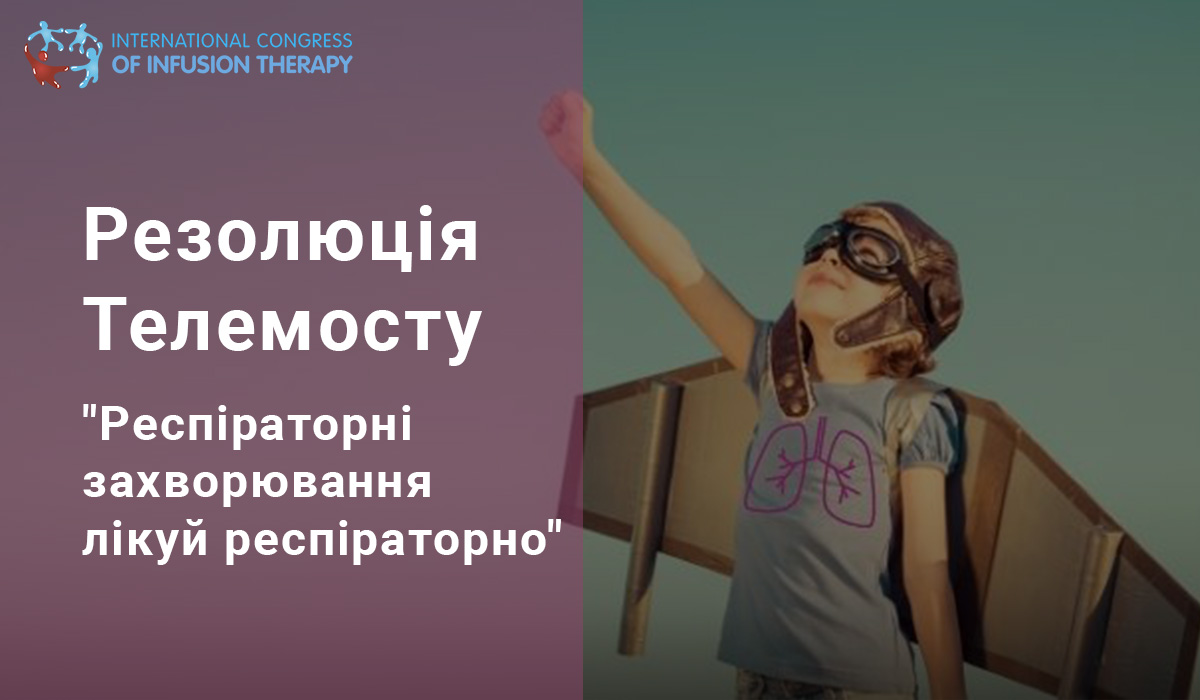Resolution of the Teleconference "Respiratory diseases shall be treated in respiratory organs"
19-03-2021

Almost 6 000 health care specialists from all regions of Ukraine have registered to participate in the Teleconference “Respiratory diseases shall be treated in respiratory organs. Respiratory cytoprotection – is it the future perspective or existing opportunity?”, which took place on March 16, 2021.
As part of the event the experts in Pediatrics, Allergology and Pulmonology have shared their thoughts and experience related to respiratory cytoprotection in case of infectious-inflammatory and allergic diseases of airways.
Seven main reports were offered to the participants for review and they were dealing with the following issues:
- What is respiratory cytoprotection?
- How will it help to improve efficiency of treatment of respiratory diseases?
- Who and when should use respiratory cytoprotection?
- An opportunity to use nebulizers for treatment of respiratory diseases during pandemic.
- Panel discussion by medical experts was devoted to discussion of capabilities of respiratory cytoprotection at different pathological conditions: allergic and infectious rhinitis, bronchitis.
Conclusions and decisions based on discussion of reports:
- Nebulizer therapy is an efficient way of treatment of respiratory diseases. The selection of drugs for nebulizer therapy should be made carefully and solutions recommended for use with nebulizers should be chosen. No consensus paper on use of nebulizers prohibits their use during increase in body temperature. It is not prohibited to use nebulizers during pandemic COVID-19 by patients who need local treatment of respiratory diseases.
- In the context of respiratory diseases use of antibiotics should be well-minded and considered. Glucocorticosteroids, which are the most efficient therapeutic agents for treatment of other inflammatory diseases, have secondary importance for treatment of chronic neutrophillic inflammation and COPD. Neutrophils are less sensitive to glucocorticoids than other immune cells. Acquired resistance of neutrophils to glucocorticoids is frequently observed in patients with COPD. The cytoprotective therapy through inhaled administration of Ectoin may be used for more efficient treatment of patients with respiratory diseases, in particular with chronic bronchitis/COPD.
- Uncontrolled use of decongestants may cause excessive drying and further atrophy of mucosa. The respiratory cytoprotector may take an important place in treatment of patients with rhinitis as far as it creates barrier on the nose mucosal surfaces, protects from viruses and bacteria, and decreases dryness of mucosa when there is a need to use vasoconstrictors.
- The allergic rhinitis as a barrier disease is an IgE-mediated inflammatory disease of nose mucosae, which is caused by the influence of allergens. In comparison to non-allergic, idiopathic or acute rhinitis the allergic rhinitis is characterized by epithelial dysfunction. The latest data testify that barrier dysfunction promotes development and progression of allergic rhinitis. Restoration and protection of mucus barrier of airways may become a useful approach to treatment of allergic diseases, and allergic rhinitis in particular. In this context use of respiratory cytoprotector based on Ectoin is a far-reaching possibility.
- Bronchial hyperreactivity is a pathophysiological basis of some diseases of respiratory system of children which has allergic, neurogenic and myogenic development mechanism. Epithelial injury is one of mechanisms of bronchial hyperreactivity that facilitates access of antigen and other macromolecules to submucosa cells. Inhalation of respiratory cytoprotector based on Ectoin is a promising preparation for prevention and treatment of bronchial hyperreactivity and diseases having such pathogenetic mechanism (post viral hyperreactivity, chronic bronchitis, asthma, recurrent bronchitis, etc.) due to the fact that Ectoin modulates cytokine profile of bronchoalveolar lavage in the direction of anti-inflammatory action (in particular, interleukin-4 is responsible for synthesis of IgE, interleukin-8 simulates neutrophillic inflammation, interleukin-6 is a pro-inflammatory cytokine of acute phase).
- Taking into account causative factors one should not use antibiotics for treatment of acute bronchitis even if a child has a cough for more than 8-10 days. Unreasonable antibiotic treatment has adverse consequences, increases expenses for health care and facilitates development of antibiotic resistance. Treatment with nebulizers is efficient and safe as far as only casual drugs are prescribed and they are appropriate for nebulizers. It is recommended to use inhaled antiseptic drugs having simultaneously viricidal action and antibacterial effect (Decamethoxinum ) for causal treatment of bronchitis. Inhaled mucolytics that act directly in the airways should be considered as symptomatic treatment for better sputum liquefaction and release (3% hypertonic saline and 0.1% hyaluronic acid).
- 50% of children under age 6 years have ARVI complicated with broncho-obstructive syndrome, 25% of them often have disease recurrence and face a high risk of asthma development. There is an alternative for term “broncho-obstructive syndrome” which is more modern and widely used in medical books. It is “wheezing syndrome” and its treatment is described in details in international recommendations.
- Use of salbutamol through nebulizer or spacer is the first step for treatment of wheezing in children. Ipratropium bromide should be added in case of sever wheezing only. It is not recommended to use oral bronchial spasmolytics as far as they have many side effects and are less efficient in comparison to inhaled bronchial spasmolytics.
- Occasional use of inhaled corticosteroids may be considered for children with frequent viral induced wheezing episodes and occasional symptoms of asthma. Nebulized fluticasonum propionate is a choice in case of wheezing.
- It is recommended to use solutions in single-dose containers for inhalation through nebulizer as far as they contain fewer preservatives in excipients.
You can download the text of the Resolution by this link.
Have you registered for our events before?
Subscribe to VIBER-BOT ‘Infusiontherapy’ – get up-to-date information, interesting announcements and news on the topic of infusion therapy!
Didn’t see all the reports? View the video recording of the conference:
